
Geoglyphs portraying entire cities
— Tell us about your research.
My research is in the field of media arts. I’m working on creating geoglyphs using satellite data, focusing on the link between space and art.
— You took part in in a joint research art project with JAXA using the Advanced Land Observing Satellite-2 (ALOS-2) DAICHI-2, which was launched last May. Can you tell us a little more about the project?
 Radio wave reflectors imaged by DAICHI-2 (courtesy: JAXA)
Radio wave reflectors imaged by DAICHI-2 (courtesy: JAXA)
Yes, it’s known as the Daichi Constellation Project. We use satellites to create geoglyphs – giant works of art that can be seen from high above. The DAICHI-2 satellite has an instrument called “Phased array type L-band Synthetic Aperture Radar,” known as PALSAR-2. We made radio-wave reflectors, and used them to capture waves from PALSAR-2. From up high, the radio-wave reflectors appeared as white spots – almost like stars. We placed the reflectors strategically, to create arrays of white spots, which looked a lot like constellations of stars. On December 26, 2014, we visited eight elementary schools in Kagoshima to allow children to create geoglyphs. This was part of the Children’s Space Art Classroom, sponsored by Minamitane in Kagoshima. Two hundred students took part in creating what we called the Tanegashima Constellation. We plan to hold similar geoglyph events for local children in Tsukuba City on February 21, 2015, Moriya City on March 7, and Kanazawa City on October 4.
— So we can look forward to a Tsukuba Constellation, Moriya Constellation, and Kanazawa Constellation, right? Do we have to provide our own radio-wave reflectors? Is there a certain number that is needed?
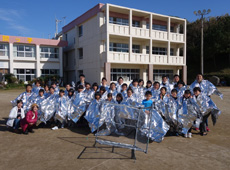 Students dressed to act as human reflectors. The radio-wave reflectors are in the foreground.
Students dressed to act as human reflectors. The radio-wave reflectors are in the foreground.
The radio-wave reflectors can be made using materials found at your local hardware store. They are foldable, lightweight, and easy to carry. When folded, they’re just one meter square and 15 cm thick, and weigh just 2.5 kg. The number of reflectors you need for this project depends on the location, and at any rate, the concept is to constantly create new constellations in different cities. We decide when to create the geoglyphs, and how to orient the reflectors to maximize their brightness, based on DAICHI-2’s orbit. For the Tanegashima Constellation, we set up reflectors in nine locations: eight elementary schools in Minamitane, and the Tanegashima Space Center. The children wore reflective aluminum material and positioned themselves around the radio-wave reflectors to make the “stars” look bigger. The idea to use human reflectors actually came from my laboratory. It was first attempted by the general public at the JAXA Earth Observation Center in November 2014, and the image it produced was really wonderful. So we decided to try it at Tanegashima as well.
— Creating a new constellation in each city is an interesting goal.
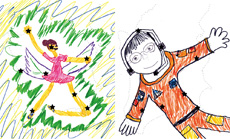 Constellation drawn by children in Tanegashima.
Constellation drawn by children in Tanegashima.
Well, it may be more accurate to say that the children in each city create their own constellation. The previous time we held the Children's Space Art Classroom and Lecture Workshop in Tanegashima, we had the children make their constellation using templates from actual constellation in Tanegashima. In the past, constellations were used by travelers for navigation, and also to predict the future. In this sense, we wanted the children to draw pictures of constellations as a reflection of their dreams. The children produced constellations of ballet dancers, astronauts, and other images that had a special meaning for them. Creating the geoglyphs is a unique experience for the children, which we hope they will leave a lasting impression.
Encouraging the study of Earth from space
— Does the experience of creating original “constellations” help children develop an interest in space.
 Satellite tours at the Tanegashima Space Center.
Satellite tours at the Tanegashima Space Center.
Yes, the purpose of this project is to raise awareness and interest in both space and art. We want children to think about space as they create these constellations. Before DAICHI-2 was launched, we held public tours to introduce it to the public. Developers from the JAXA Earth Observation Research Center gave talks on the radar system and the images that can be generated from its radio waves. Children can see the satellite with their own eyes before they’re launched, and that allows them to develop some feeling of personal involvement with them. This creates a sense of excitement and wonder in children, when they think about these satellites photographing them from space. I think this really changes the way kids look at satellites. Using satellites to draw their constellations gives them a direct connection with scientific knowledge and also has significance for the practice of space art.
— What was the spark that brought this project to life?
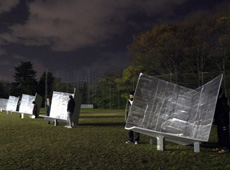 Image from 2010 experiment.
Image from 2010 experiment.
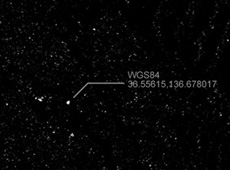
Geoglyphs drawn in 2010. Work titled "Microcosm/November 29th, 2010 at 10:18 p.m. in Kanazawa " (courtesy: PALSAR Level 4.1: Processed by ERSDAC, Observed raw data: Belong to METI and JAXA, Changed from an original color by Hiroshi Suzuki.)
I have always had an interest in looking at the Earth from an external perspective, and I have always pursued ways to look at the Earth from space. I wasn’t satisfied with being involved in a passive capacity – just looking at images of Earth provided by space agencies. I wanted to use space resources myself to view our planet, and I felt that satellites were the key to achieving this. So I studied how to create geoglyphs using the DAICHI satellite, which was the predecessor to DAICHI-2. I performed an experiment: I set up radio-wave reflectors made by students from the Kanazawa College of Art at several locations in Kanazawa City, and then reflected satellite radar to create geoglyphs. Radar can be imaged regardless of weather conditions, which was an advantage, since it could have been raining the day the satellite passed over Kanazawa. One month after setting up the reflectors and taking images for this experiment, I took another image without using reflectors. I planned to extract the differences between these two images, and to show traces of changes in the city, as represented by a starry sky. As a result of this experiment, I learned that the reflectivity of radar changes due to normal human activity such as traveling in cars, and that these changes appear as stars. However, the DAICHI satellite ceased operation before I could perform my second experiment, and so my research stopped. Afterwards, I learned about the work JAXA was doing on DAICHI-2. I applied to participate, and was then able to continue my research under the Daichi Constellation project.
— Your desire to see the Earth from outside led to your ties between satellites and art?
Yes, I want to actually be involved in the process, and I also want others to experience this active involvement. I certainly wanted those involved in this project to experience a more involved view of the Earth, and so I felt I could achieve that goal by using satellites that could reflect us in some way. For example, there are people who like to watch plays, and there are those who would rather get up on stage and participate. I am the latter. I want to be involved in some way. I believe that gaining a new perspective of our planet has positive effects on a person’s awareness of social issues.
Equal parts art and education
— The university students who participated in the project – how did they respond?
While there was certainly a sense of joy in creating geoglyphs from satellite images, what I found most interesting is that many participants really loved helping the children experience this same feeling. In other words, this project had immense value as an educational activity. For example, students of the Kanazawa College of Art as well as students in the Education Department of Kagoshima University took part in the elementary-school workshops last October. The education students told us they were willing to spend their own money to take part in the imaging event in December. The kids too were excited and eager to participate in the workshops, which made the experience enjoyable for the teachers, and created a lot of interest.
— Have you experienced any changes personally from conducting this project?
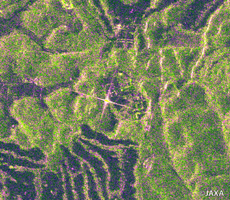
Images taken by DAICHI-2 of a public event at the JAXA Earth Observation Center. (courtesy: JAXA)
My view of the Earth has changed considerably. I was particularly moved during the part of the project when the human reflectors were included in the satellite images. I realized that radio waves from space could be reflected by just one person on Earth and sent back into space. I exist as one part of the whole on Earth. It gave me a feeling of certainty about my own existence.
— What challenges are there in using satellites?
What I learned from this project is that most people don’t know that satellites are available for this. Everybody was surprised when they first learned that satellites could be used for personal purposes; now some teachers may want to use satellites in their classes. But it is difficult to know when a satellite will pass over your city – the path and orbit of the satellite can be forecast, but this is not very reliable. It is also difficult to make observation requests for certain specific locations to be imaged. If this can be improved, it would increase the potential for various activities related to space and art.
How space art affects our lives
— What’s next for the Daichi Constellation project?
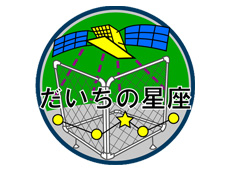 DAICHI Constellation project logo.
DAICHI Constellation project logo.
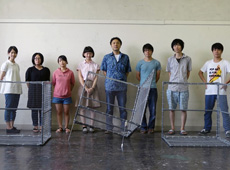 Dr. Suzuki (center) and student participants.
Dr. Suzuki (center) and student participants.
For the upcoming Tsukuba Constellation and Moriya Constellation projects, I provided instructions on making the radio-wave reflectors and created a group of participants. Reflectors were placed at this group’s activity bases, which should result in a constellation that we could never have predicted. I want the project to grow in a way that surpasses our expectation and predictions, where more and more people get actively involved, independently of the original project owners. In the future, I would also like to expand this project all over the world. I would like the people of the world to share a sense of togetherness that surpasses ethnicity, region, religion, and any other barriers that separate us when they view the Earth from space and experience seeing themselves in such images.
— Are there any specific pieces of space art you want to make?
The Daichi Constellation project contains only still images. Next, I would like to create a video piece using the Cupola module of the International Space Station. I want to image the Japanese Islands from Cupola, and then combine these images with images taken on Earth during the same time period, to create a video. Video of cities at night taken from space may only show arrays of light, but this actually represents the activity of many people going about their daily lives. I want to attempt a project that will show Japan as seen from space in real time, while also showing human activity in Japan up close. This may be difficult on a technical level, but I am sure this will create yet another view of the Earth.
— What are your expectations of JAXA?
I would like to see experiments in art on the International Space Station (ISS) restarted. Japan pioneered the idea of missions with a focus on culture and the humanities, and started a space-art experiment with the Japanese Experiment Module Kibo in 2008. Unfortunately, these types of experiments are no longer supported. But after seeing the effect of such experiments on students and young researchers, I believe such activities are very important. There has been some debate recently about the benefit the ISS brings to the public, so perhaps these experiments were canceled for cost-cutting reasons. But I feel it is just as important to stimulate people’s hearts as it is to provide tangible benefits for everyday life. So, I would like to see space-art experiments restarted and Japan’s world-leading research continue.
- Photos courtesy:
- Kanazawa College of Art, except as indicated
Hiroshi Suzuki, Ph.D.
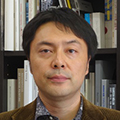
Associate Professor of Oil Painting, Kanazawa College of Art
After completing Ph.D. courses at the Kanazawa College of Art in 2000, Dr. Suzuki moved to Italy to study at the Academy of Fine Arts of Brera (Rotary Foundation International Ambassadorial Scholarship, 2001-2002; Italian Government Scholarship, 2002-2003). He received jury recommendations in the Art Division of the Japan Media Arts Festival each year between 2007 and 2009. He was chosen to assist in the Project to Support the Nurturing of Media Arts Creators at the Japan Media Arts Festival in 2010, and conducted the Kanazawa Satellite Art Project, which was the predecessor to the Daichi Constellation project. He is a member of the Japan Film Society.
[ Mar. 13, 2015 ]